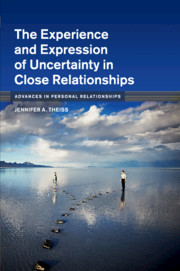Book contents
- The Experience and Expression of Uncertainty in Close Relationships
- Advances In Personal Relationships
- The Experience and Expression of Uncertainty in Close Relationships
- Copyright page
- Dedication
- Contents
- Figures and Tables
- Acknowledgments
- Part I Conceptual and Theoretical Foundations of Uncertainty in Close Relationships
- Part II Antecedents and Consequences of Uncertainty in Close Relationships
- Part III Communicating and Coping Under Conditions of Uncertainty in Close Relationships
- Part IV Refining the Conceptualization and Operationalization of Uncertainty in Close Relationships
- References
- Index
- References
References
Published online by Cambridge University Press: 12 December 2017
- The Experience and Expression of Uncertainty in Close Relationships
- Advances In Personal Relationships
- The Experience and Expression of Uncertainty in Close Relationships
- Copyright page
- Dedication
- Contents
- Figures and Tables
- Acknowledgments
- Part I Conceptual and Theoretical Foundations of Uncertainty in Close Relationships
- Part II Antecedents and Consequences of Uncertainty in Close Relationships
- Part III Communicating and Coping Under Conditions of Uncertainty in Close Relationships
- Part IV Refining the Conceptualization and Operationalization of Uncertainty in Close Relationships
- References
- Index
- References
- Type
- Chapter
- Information
- Publisher: Cambridge University PressPrint publication year: 2017

